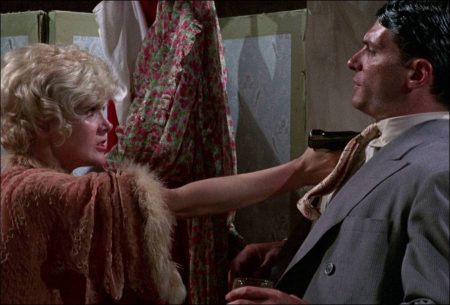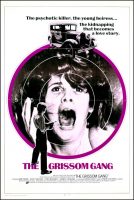Taglines: The psychotic killer, the young heiress…the kidnapping that becomes a love story.
The Grissom Gang movie storyline. Barbara Blandish (Kim Darby), a young Kansas City heiress, gets kidnapped by some inept local hoodlums for the diamond necklace she is wearing, and then gets kidnapped a second time by the Grisson gang demanding a million dollar ransom. THe Grissons, a family of depraved, ruthless poor white trash, is led by Ma Grissom, a fury whose mustache and house dress clash, whose belief it is that kidnapping plots go awry because the victim is allowed to live. But plans go haywire when her son Slim, a psychopathic, knife-wielder, falls in love with Barbara. Her billionaire father hires Dave Fenner, a cynical private detective, to find her.
The Grissom Gang is a 1971 American crime neo noir directed and produced by Robert Aldrich from a screenplay by Leon Griffiths. The film is the second adaptation of the 1939 novel No Orchids for Miss Blandish by James Hadley Chase; a previous version had been made in Britain in 1948. The cast includes Kim Darby, Scott Wilson, Tony Musante, Robert Lansing, Irene Dailey, Connie Stevens, Wesley Addy, Joey Faye and Ralph Waite.
About the Production
The film was based on the novel No Orchids for Miss Blandish which had been controversial ever since originally published. It had been turned into a controversial British film in 1948.
Gene D. Phillips of Loyola University of Chicago wrote that “It is a matter of record that [the novel] No Orchids for Miss Blandish was heavily indebted to Sanctuary for its plot line.” Therefore, he considers this film to be inspired by Sanctuary.
The success of The Dirty Dozen led to Robert Aldrich signing a multi-picture contract with ABC Pictures. In May 1970 Martin Baum, president of ABC, announced Aldrich’s company, Aldrich and Associates, would make The Grissom Gang, in June, at Aldrich’s studios.[5] Filming was pushed back to July.
Aldrich says he was partly inspired to make it by the fact it was set in the 1930 and would not be in as much danger of being dated. “You have to be terribly careful about not making a picture that will be affected by a change in the audience’s framework of acceptance between the time you start and the time you finish”, he said. “That’s an enormous problem. Whatever you say today risks strongly going out of date in the fifteen month time-lag between the start of shooting and release.”
Lead roles went to Kim Darby, best known for True Grit, and Scott Wilson, best known for In Cold Blood. Darby said “every actress in town had been up for” her role, with Michelle Phillips and Barbara Hershey among those who tested. Darby says “I really learned a lot from Mr. Aldrich during the shooting… and I think that it’s a terrible picture. But working with Aldrich was the most enjoyable and funny time I ever had. There was nothing like it.”
Wilson had been offered a lot of roles as murderers after In Cold Blood and turned them down. He accepted the part of Slim Grissom because he “was much more than just a killer. And there’s a love story involved.” (Bruce Dern had tested unsuccessfully for the part.)
Aldrich later said ABC insisted on certain people being cast. The cast had two weeks of rehearsal. Wilson called Aldrich “amazing. He’s in such control but he’s so easy.”
“I don’t think Mr. Aldrich ever even referenced the novel while we were shooting”, said Darby. “At that time, I had thought that we were working off of an original screenplay.”
The film originally ended with Blandish committing suicide by jumping in the river. But after test screenings this was changed as it was felt unnecessary since “her life was lost and useless anyway” according to Aldrich.
The Grissom Gang (1971)
Directed by: Robert Aldrich
Starring: Kim Darby, Scott Wilson, Tony Musante, Robert Lansing, Irene Dailey, Connie Stevens, Wesley Addy, Joey Faye, Ralph Waite, Hal Baylor, Matt Clark, Alvin Hammer, Dots Johnson
Screenplay by: Leon Griffiths
Production Design by: Fred Ahern
Cinematography by: Joseph Biroc
Film Editing by: Michael Luciano, Frank J. Urioste
Costume Design by: Norma Koch
Set Decoration by: John Brown
Art Direction by: James Dowell Vance
Music by: Gerald Fried
MPAA Rating: None.
Distributed by: Cinerama Releasing Corporation
Release Date: May 28, 1971
Visits: 105

